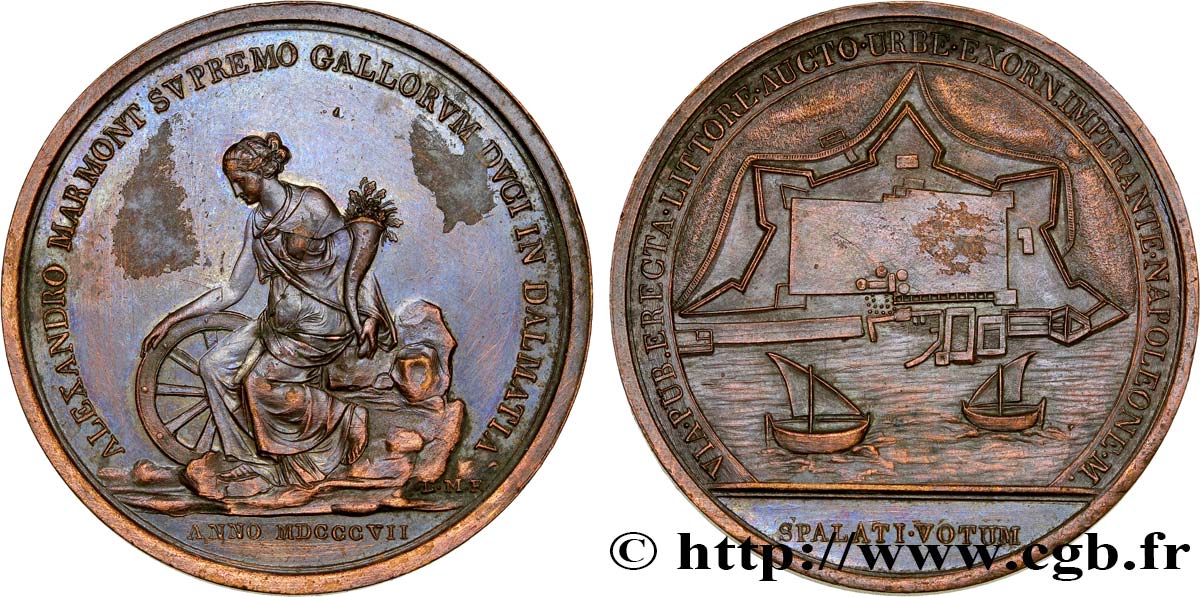fme_370955 - PRIMER IMPERIO Médaille du général Marmont
No disponible.
Artículo vendido en nuestra tienda (2016)
Precio : 180.00 €
Artículo vendido en nuestra tienda (2016)
Precio : 180.00 €
Tipo : Médaille du général Marmont
Fecha: 1807
Nombre del taller / ciudad: Croatie, Split
Metal: bronce
Diámetro: 42,5 mm
Eje de acuñación: 12 h.
Acuñador L. M. F.
Peso: 39,5 g.
Canto: lisse
Comentarios sobre el estado de conservación:
Superbe médaille, probablement brossée, avec des traces de papier collé
Anverso
Titulatura del anverso: ALEXANDRO MARMONT SVPREMO GALLORVM DVCI IN DALMATIA // ANNO MDCCCVII.
Descripción del anverso: Dalmatie, tenant une corne d'abondance de la main gauche, sa droite repose sur une roue.
Reverso
Titulatura del reverso: VIA. BUB. ERECTA. LITTORE. AUCTO. URBE. EXORN. IMPERANTE. NAPOLEON. M. //SPALATI. VOTUM.
Descripción del reverso: Le plan de la ville de Spalatro montrant deux bateaux sur l'océan.
Comentario
Cette médaille a été frappée en l'honneur du général Marmont par les habitants de Spalatro en Dalmatie.
http://www.napoleonicmedals.org/coins/br-687.htm
Auguste-Frédéric-Louis Viesse de Marmont, duc de Raguse (1808), maréchal d'Empire (1809) et pair de France (1814), est un militaire français né le 20 juillet 1774 à Châtillon-sur-Seine et mort le 3 mars 1852 à Venise.
Fils d'officier de petite noblesse, il commence sa carrière militaire comme simple lieutenant lors des guerres de la Révolution. En 1793, lors du siège de Toulon, il s'attache au général Bonaparte et dans son sillage connait une ascension fulgurante : colonel en 1796, général de brigade en 1798, général de division en 1800 et général en chef de l'armée de Hollande en 1804. Bonaparte, devenu entretemps consul puis empereur, le choisit pour des missions éloignées du théâtre principal des opérations militaires. C'est ainsi qu'il est envoyé à la tête d'une armée française en Dalmatie en 1806, dont il est nommé gouverneur général avant d'être fait duc de Raguse en 1808. En 1809, il participe à la campagne d'Autriche et sa victoire de Znaïm lui vaut d'être fait maréchal d'Empire puis gouverneur général des Provinces illyriennes..
This medal was struck in honor of General Marmont by the inhabitants of Spalatro in Dalmatia.
http://www. Napoleonic medals. org/coins/br-687. htm Auguste-Frédéric-Louis Viesse de Marmont, Duke of Ragusa (1808), Marshal of the Empire (1809) and Peer of France (1814), was a French soldier born on July 20, 1774 in Châtillon-sur-Seine and died on March 3, 1852 in Venice.
The son of a minor nobility officer, he began his military career as a simple lieutenant during the Revolutionary Wars.. In 1793, during the siege of Toulon, he became attached to General Bonaparte and in his wake experienced a meteoric rise: colonel in 1796, brigadier general in 1798, divisional general in 1800 and general-in-chief of the army of Holland in 1804.. Bonaparte, who had in the meantime become consul and then emperor, chose him for missions far from the main theatre of military operations.. This is how he was sent to lead a French army in Dalmatia in 1806, where he was appointed governor general before being made Duke of Ragusa in 1808.. In 1809, he took part in the Austrian campaign and his victory at Znaim earned him the title of Marshal of the Empire and then Governor General of the Illyrian Provinces..
http://www.napoleonicmedals.org/coins/br-687.htm
Auguste-Frédéric-Louis Viesse de Marmont, duc de Raguse (1808), maréchal d'Empire (1809) et pair de France (1814), est un militaire français né le 20 juillet 1774 à Châtillon-sur-Seine et mort le 3 mars 1852 à Venise.
Fils d'officier de petite noblesse, il commence sa carrière militaire comme simple lieutenant lors des guerres de la Révolution. En 1793, lors du siège de Toulon, il s'attache au général Bonaparte et dans son sillage connait une ascension fulgurante : colonel en 1796, général de brigade en 1798, général de division en 1800 et général en chef de l'armée de Hollande en 1804. Bonaparte, devenu entretemps consul puis empereur, le choisit pour des missions éloignées du théâtre principal des opérations militaires. C'est ainsi qu'il est envoyé à la tête d'une armée française en Dalmatie en 1806, dont il est nommé gouverneur général avant d'être fait duc de Raguse en 1808. En 1809, il participe à la campagne d'Autriche et sa victoire de Znaïm lui vaut d'être fait maréchal d'Empire puis gouverneur général des Provinces illyriennes..
This medal was struck in honor of General Marmont by the inhabitants of Spalatro in Dalmatia.
http://www. Napoleonic medals. org/coins/br-687. htm Auguste-Frédéric-Louis Viesse de Marmont, Duke of Ragusa (1808), Marshal of the Empire (1809) and Peer of France (1814), was a French soldier born on July 20, 1774 in Châtillon-sur-Seine and died on March 3, 1852 in Venice.
The son of a minor nobility officer, he began his military career as a simple lieutenant during the Revolutionary Wars.. In 1793, during the siege of Toulon, he became attached to General Bonaparte and in his wake experienced a meteoric rise: colonel in 1796, brigadier general in 1798, divisional general in 1800 and general-in-chief of the army of Holland in 1804.. Bonaparte, who had in the meantime become consul and then emperor, chose him for missions far from the main theatre of military operations.. This is how he was sent to lead a French army in Dalmatia in 1806, where he was appointed governor general before being made Duke of Ragusa in 1808.. In 1809, he took part in the Austrian campaign and his victory at Znaim earned him the title of Marshal of the Empire and then Governor General of the Illyrian Provinces..








 Informar de un error
Informar de un error Imprimir la página
Imprimir la página Comparte mi selección
Comparte mi selección Haz una pregunta
Haz una pregunta Consignar / vender
Consignar / vender
 Descriptivo
Descriptivo











